[vc_row][vc_column width=”1/2″][vc_column_text]
General Information – The Marae
The marae (meeting place) is a Māori community facility which consists of a carved meeting
house (wharenui), a dining hall (whare kai) and cooking area as
well as the marae atea (sacred space in front of the meeting house).
The marae is a symbol of tribal identity. It is a meeting place
where people can discuss and debate various issues, and is considered
by Māori as a turangawaewae (a standing place, a place of belonging).
It is the area of greatest mana (prestige, power), the place of
greatest spirituality, the place in which Māori customs are
given ultimate expression.
On the marae, official functions take place ;
celebrations, weddings, christenings, tribal reunion, funerals.
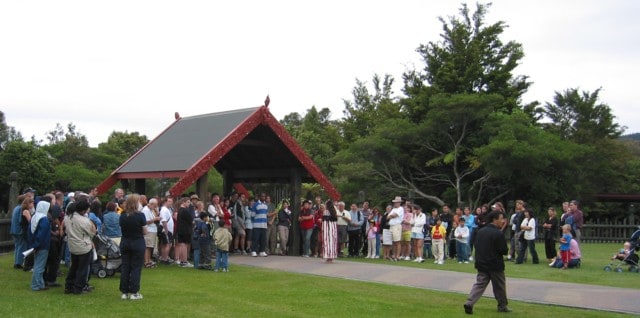
Whakarewarewa Marae, Rotorua New Zealand.
Visitors arriving at Wakarewarewa Rotorua.
Karanga
The karanga is an exchange of calls that takes place during the time a visiting group moves onto the marae, or into the formal meeting area.
The karanga usually indicates the start of the pōwhiri (formal welcome ceremony). Carried out exclusively by women and in the Māori language, karanga is initiated by the hosts (tangata whenua).
The karanga generally begins with the initiating caller (kaikaranga) from the tangata whenua, and response caller (kaiwhakatu) from the manuhiri.
Like the whaikōrero (formal speech of welcome), karanga follow a format in keeping with correct protocol.
The call also clears a spiritual pathway for the ancestors of both visitor and host to meet and partake in the ceremonial uniqueness of the pōwhiri.
It is normal for both kaikaranga (women who carry out the karanga) to address and greet each other and the people they are representing.
To address and pay tribute to the dead of each other’s acquaintance (especially those who have most recently died), and to refer to
the reason that has brought the two groups together.
There is no restriction on how long the exchange lasts nor on the number of women who participate, but not all women are skilled in performing karanga, and on any one occasion only a few women normally karanga. The exchange generally lasts until the visitors have stopped momentarily in respect directly in front of the meeting house (marae atea). After standing in silence for a short time, a final karanga is sometimes offered by a host kuia (female elder) to indicate that the visitors should take their seats.
[/vc_column_text][/vc_column][vc_column width=”1/2″][vc_column_text]
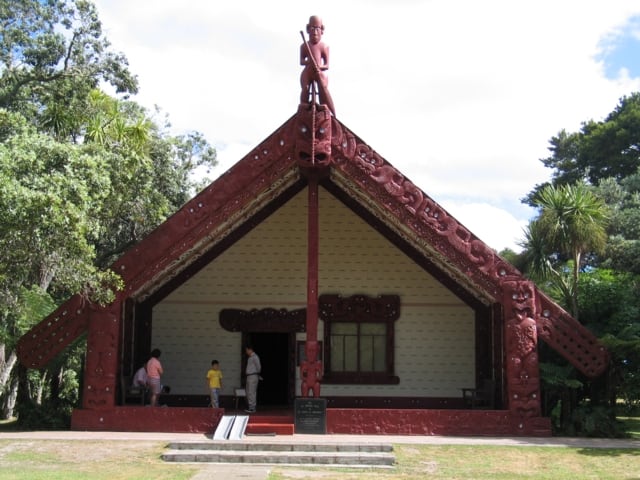
Te Whare Runanga, Māori meeting house.
Te Whare Runanga, Maori meeting house at the Waitangi Treaty Grounds, New Zealand.
Arrival
Confirm the time of arrival with the tangata whenua
(local people of the marae). In most tribal areas you should
plan to arrive during daylight hours.
Upon arriving at the marae your group (manuhiri)
should assemble at the main gate (waharoa) and would
be told where the women will be placed. This will indicate
to the tangata whenua (hosts) that you are
ready to proceed onto the marae.
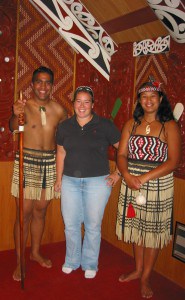
Inside Whakarewarewa Marae.
Visitor pictured with two performers from the Powhiri Group inside Whakarewarewa Marae.
[/vc_column_text][/vc_column][/vc_row][vc_row][vc_column width=”1/3″][vc_column_text]
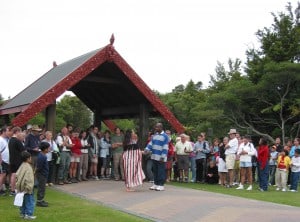 Whakarewarewa Marae.
Whakarewarewa Marae.
The kaikaranga explains, to the male leader (kaikorero), who will do the whaikōrero (speeches) for the group, the protocol of the marae.
[/vc_column_text][/vc_column][vc_column width=”1/3″][vc_column_text]
Powhiri
The pōwhiri (pōhiri) is the traditional Māori process of introducing and welcoming manuhiri (visitors) onto a marae (meeting place), while maintaining the integrity and esteem of both the manuhiri and tangata whenua.
It usually begins with a wero or taki (challenge), although today not often seen on a regular basis. A warrior from the tangata whenua will challenge the manuhiri. He may carry a spear (taiaha) then lay down a rautapu (a leaf or carved effigy) that the manuhiri will pick up to
show they come in peace.
The pōwhiri ceremony is conducted entirely
in Māori and is a very formal and sacred ceremony so it is expected that the manuhiri will not talk, drink or smoke throughout this process. The marae are not the only place where pōwhiri take place – nowadays pōwhiri can happen anywhere that hosts (tangata whenua) need to formally greet a group of visitors (manuhiri).
[/vc_column_text][/vc_column][vc_column width=”1/3″][vc_column_text]
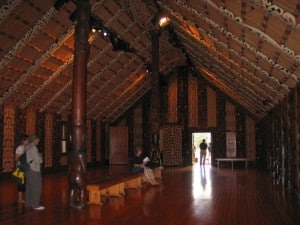
Inside Te Whare Runanga of Waitangi, the wharenui is the archive of their tribe (iwi) recording priceless
history (hitori) through the art of carving, tukutuku panels,and kowhaiwhai (scroll work on rafters)
[/vc_column_text][/vc_column][/vc_row][vc_row][vc_column][vc_column_text]
Mihi/Whaikorero
The mihi and whaikōrero are the formal greetings and speeches exchanged between hosts and visitors.
If the speeches are to be made inside the wharenui (meeting house), shoes must be removed before entering.
Protocols determining the order of speakers vary between iwi (tribe) and hapu (sub-tribe). It is the men who make the speeches usually started by a Kaumatua (local elder). The men’s speeches negate bad influences from the other side as the marae is traditionally the domain of Tumatauenga,the ‘god of war’.
The women must be protected and retreat to the back. Although they themselves almost never speak, women live longer and they are the keepers of the culture.[/vc_column_text][/vc_column][/vc_row][vc_row][vc_column width=”2/3″][vc_column_text]There are two types of speaking order for the delivery of whaikōrero used by different tribes: tau-utuutu and paeke Tau-utuutu is when the speaking order alternates. It begins with a local speaker, followed by a visiting speaker, another local speaker and so on. The last speaker is from the tangata whenua. Pāeke, all but one of the host speakers speak first. Then the right of speech is handed to the visitors. A final speaker from the hosts completes the whaikōrero phase of the pōwhiri.
As a visitor, you are expected to act in a dignified manner, for Māori accept your physical presence as representing all your ancestors.[/vc_column_text][/vc_column][vc_column width=”1/3″][vc_column_text]
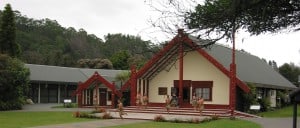 Whakarewarewa Village.
Whakarewarewa Village.
Whakarewarewa Village Pōwhiri Group.
[/vc_column_text][/vc_column][/vc_row][vc_row][vc_column][vc_column_text]
Hongi
At the conclusion of the speeches, the manuhiri (visitors) rise to greet the tangata whenua (hosts).
This entails the main body of men on the visiting side forming a single line and advancing to meet the Kaumatua (male elder) on the host side to shake hands and to hongi. Women will form a line at the rear of the men. Generally the left hand is placed on each others shoulders and the pressing of noses (hongi) twice.
Traditionaly goes back to the beginning of time symbolising Tane (the god of the forest) blowing the breath into the first human being. Once the formal welcome and reply protocol are over and with tapu (sacred, forbidden) removed from the outsider. It is at this point and with the inevitable meal to follow, that the tangata whenua and manuhiri merge as one, and become the whanau (family) of the marae for the occasion.[/vc_column_text][/vc_column][/vc_row][vc_row][vc_column width=”1/3″][vc_column_text]
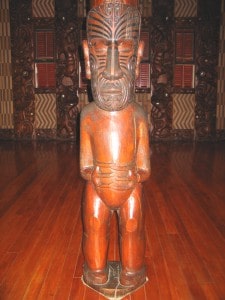
Māori Carving found inside Te Whare Runanga Waitangi Marae.
[/vc_column_text][/vc_column][vc_column width=”2/3″][vc_column_text]
Hakari
Hakari (formal banquet) is the act of feasting that traditionally applied to the eating of cooked food. The Hakari recognises the transition from the spiritual realm of the powhiri back into the physical world, where food is shared. It a celebration of unity, and a time to get to know someone or more on the marae.
One is now part of the one family or Tangata whenua (people of the land). Maraes have a wharekai (a dedicated area or building for eating). Inside there is always a festive atmosphere and sense of informality.
The kai (food), which is placed over hot stones in a hangi (earth oven) is prepared by the ringawera (cooks and kitchen workers) who are revered on every marae. The kai (food) is arranged in baskets, lowered into the pit, covered with wet sacking and finally with earth so that the steam and the flavours are kept in. The hangi is left to cook for 3-5 hours. This method of cooking has been handed down from generation to generation. Slow cooking makes the food extremely tender, with the flavours of all the foods intermingling, and the distinct taste is unforgettable.
Poroporoaki
Poroporoaki, or speeches of farewell, signifies the act of farewell and the return of mana (esteem and authority) to the host people. You and your ancestors have been welcomed in the tradition of the Māori people of Aotearoa and have experienced something special and unique.
[/vc_column_text][/vc_column][/vc_row]
